
Cardoon is a perennial celery-like looking vegetable that is closely related to globe artichoke, and is a member of the thistle family. It is prized by people from the Mediterranean countries for its unique flavor, which we think is similar to the taste of artichoke. We have found that cardoon is usually only available in the markets around Christmas time. Many people discard the tougher outer ribs, but we have found that they have excellent flavor, too, if you don't mind throwing away the stringy remains, as one does with artichoke bracts (leaves). All the ribs in this bunch are edible, as are the smaller leaves. The new growth center stalks have a frilly top which is too tough to eat and should be removed with the larger outer leaves. The inner tender stalks can be eaten raw. Cardoon is best prepared by boiling in soups and steaming. We have also stir-fried cardoon in water. See the nutritional chart by clicking on the photo or link.
Cabbage, Savoy
Posted on 7:07 AM | Be the first to comment · edit

Savoy cabbage has crinkly leaves and deep veining. We have used savoy cabbage mostly for its appearance. Be careful when selecting this variety of cabbage, as some of the heads can be quite tough. Select firm heads with flexible leaves. See the nutritional information for savoy cabbage by clicking on the photo or link..
Cabbage, Red
Posted on 7:06 AM | Be the first to comment · edit

We purchase our red cabbage in either supermarkets or farm stores (when in season), and we always look for firm heads without discoloration or imperfections. Red cabbage adds color to salads and cooked recipes. Red cabbage leaves are colored dark red/purple. However, the plant changes its color according to the pH value of the soil that it is growing in, due to a pigment called anthocyanin. In acidic soils, the leaves grow more reddish, while an alkaline soil they will produce rather greenish-yellow colored cabbages. This explains the fact that the very same plant is known by different colors in various regions. When we were children we used the juice of red cabbage as a home-made pH indicator, turning red in acid and light greenish-blue in basic solutions. On cooking, red cabbage will normally turn blue. To retain the red color it is necessary to add vinegar or acidic fruit to the pot. See the nutritional charts for raw and cooked red cabbage.
Cabbage, Green
Posted on 7:05 AM | Be the first to comment · edit
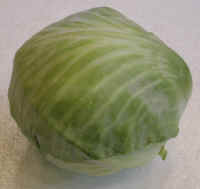
We enjoy green cabbage either raw or cooked. It is a good source of dietary fiber and vitamin C. Select heads that are firm and free of harvesting damage (cuts, cracks, etc.) or worm holes. See the nutritional tables by clicking on the photo or link.
Cabbage, Chinese
Posted on 7:04 AM | Be the first to comment · edit
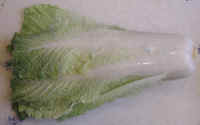
Chinese or celery cabbage is a fairly mild tasting cabbage that is great when eaten raw in a mixed green salad, or cooked in soup or Chinese recipes. Select a Chinese cabbage that is crisp and free of wilted or brownish leaf edges. Store Chinese cabbage in the vegetable drawer of the refrigerator, where it will stay crisp for several days.
Brussels Sprouts
Posted on 7:03 AM | Be the first to comment · edit

Brussels sprouts are members of the cabbage family, which they resemble in miniature form. They are a good source of dietary fiber and protein, vitamins A and C, and potassium, iron and a small amount of calcium. Like other cruciferous vegetables, Brussels sprouts have been shown to have cancer prevention properties. When purchasing, select tightly compact, firm heads with good color and without a strong odor. See nutritional charts by clicking on photo or link.
Broccoli Stir-Fry Mix, Frozen
Posted on 7:02 AM | Be the first to comment · edit

There are several brands and combinations of frozen broccoli stir-fry mix sold in the markets. This particular one contains (in order of quantity): broccoli, carrots, onions, red peppers, celery, water chestnuts, and mushrooms, and was distributed by Aldi, Inc. in 1 pound bags (2006 cost $0.89). We purchase this stir-fry mix primarily for convenience in making "quickie" soups and stir-fry recipes.
Broccoli Raab (Rabe) or Rapini
Posted on 7:01 AM | Be the first to comment · edit

Broccoli Rabe is a nutritious vegetable that is related to the turnip and has a mustard-like flavor. It is not related to broccoli, even though it has buds that look like broccoli. When purchasing, make sure that the leaves are green and crisp. Rapini origins have been traced to the Mediterranean region around Italy and to China, where it remains popular in both of these nationalities cooking. We have included nutritional charts for both raw and cooked broccoli rabe. As can be seen in these charts, this is one of those vegetables that cooking releases more of the food value. To enlarge the photo and see the nutritional charts, click on the photo or link.
Broccoli
Posted on 6:59 AM | Be the first to comment · edit

Broccoli is the nutritional leader of the cruciferous family of vegetables, which have been shown to help protect against colorectal, stomach and respiratory cancers. We enjoy broccoli raw in our salads and for dips, or cooked in stir-fries or in Italian dishes such as pizza and pasta prima vera. When purchasing, select broccoli that is firm (crisp) and with dark green florets. See the nutritional chart by clicking on the photo or link.
Bok Choy
Posted on 6:59 AM | Be the first to comment · edit
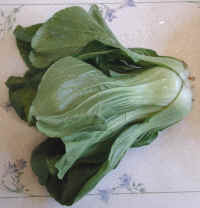
This is a northern variety of bok choy that we purchased from a local farmer in New York State. It is very tasty, with a stronger mustard flavor in the green leaves than the store bought variety, which we understand comes from California. The thickened base part of the leaves has the same mild flavor of the California variety. In this variety the green color extends down to the base, where as the California variety is white at the base. This variety is great in soups and stir-fries. The only nutritional information we have for Bok Choy is for the California variety.
Bok Choy
Posted on 6:58 AM | Be the first to comment · edit

Bok choy is also called Chinese mustard cabbage. It has a mild flavor, and can be eaten raw in salads (like any cabbage), stir-fried, or added to soups. A 100 gram (3-1/2 oz.) portion has only 13 calories. See complete nutritional charts by clicking on the photo or link.
Beets and Beet Greens
Posted on 6:57 AM | Be the first to comment · edit
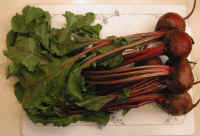
The beets in this photo were purchased in bunches of three beets each. They measure approximately two feet from the base of the roots to the top of the leaves (greens). Since both the beet root and the leaves are edible and nutritious, we purchase beets that have firm and undamaged roots and leaves that are fresh with no sign of wilting. We eat beet roots and greens raw in our salads and veggie drinks, as well as cooked in various ways (see our beet recipes and information). To enlarge the photo and see the nutritional information, click on the photo or link.
Beans, Green
Posted on 6:57 AM | Be the first to comment · edit

The most commonly eaten fresh beans are the green beans, which are also called snap beans or string beans. The outer green covering is an edible bean pod. We enjoy them raw in salads or with dips, or cooked plain or in other dishes. Select beans that are young (without large bulges in the pod from maturing beans), firm, and bright in color and without blemishes. The outer texture of the bean should feel velvety. See the nutritional charts by clicking on the photo or link for raw and cooked green beans.
Asparagus, White
Posted on 6:56 AM | Be the first to comment · edit

When we first saw white asparagus in the market, it attracted our attention. The first thing we did was compare the package nutrition information with that of regular green asparagus, and found that the white asparagus was less nutritious. It was promoted as "gourmet white asparagus", but after tasting it, we thought it would have better been promoted as "novelty white asparagus". It has an earthy taste with very little of the traditional asparagus taste. It is probably best cooked and served in combination with green asparagus. See our asparagus recipe directory for helpful suggestions. We could not find complete nutritional information for white asparagus.
Asparagus
Posted on 6:55 AM | Be the first to comment · edit

The parts of the asparagus that we eat are the sprouts. Once the asparagus sprouts begin to branch out, the stems become very woody, and actually will grow into a plant that looks like a little tree with small flowers and red berries. Select asparagus that is firm, bright green, and still tender (not soft) at the bottom and not dried out. The thickness of the stem will vary from 1/4 - 3/4 inch in diameter at the base. The thicker ones have a tendency to get somewhat woody at the base, but the flavor is the same. It will store in the refrigerator for a few days, but we usually try to eat it no more than two days after purchase. When ready to use, before removing the market's rubber bands from the bunch, we cut off about 1/2 inch from the bottoms. See our asparagus recipe directory for helpful suggestions. To enlarge the photo and see the nutritional chart, click on the photo or link.
Artichoke
Posted on 6:51 AM | Be the first to comment · edit
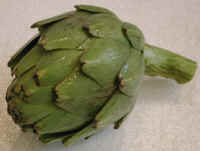
All commercially grown artichokes in the United States come from California, particularly the central coast where cool summers and mild winters provide an ideal growing area. The globe artichoke, a member of the composite family of flowers, is closely related to the thistle. If left to flower, the plants produce violet blossoms measuring seven inches across. The part we eat is from the immature flower bud. The edible portion of the "globe" is composed of the fleshy bases of the flower bracts (look like leaves) and the receptacle to which the bracts are attached, commonly referred to as the "heart." Artichokes can be purchased all year long, but the best quality are available from March through May. Select artichokes that are dark green, heavy for their size and blemish-free. The globe should be compact and not beginning to open. Artichokes can be washed, placed in a plastic bag, and stored in the refrigerator for several days until used. To enlarge the photo and see the nutritional chart, click on the photo or link. See Artichoke, Cooking and Eating
IFTECH PAKISTAN - A PROVEN RECIPE FOR SUCCESS
Posted on 6:49 AM | Be the first to comment · edit

The 7th edition of the International Food & Technology Exhibition is aimed at serving the closely integrated food industry of Pakistan.
Being an agriculture based country with a population of over 160 million, Pakistan is an ideal platform for companies seeking to expand their businesses in the global food and beverage processing sector. IFTECH Pakistan 2010 is all set to bring together the local and international industry leaders from the food and beverage processing, packaging, storage and allied industries in a highly focused environment with various networking opportunities.
Food manufacture
Posted on 6:48 AM | Be the first to comment · edit

Packaged foods are manufactured outside the home for purchase. This can be as simple as a butcher preparing meat, or as complex as a modern international food industry. Early food processing techniques were limited by available food preservation, packaging and transportation. This mainly involved salting, curing, curdling, drying, pickling, fermentation and smoking.[27] Food manufacturing arose during the industrial revolution in the 19th century.[28] This development took advantage of new mass markets and emerging new technology, such as milling, preservation, packaging and labeling and transportation. It brought the advantages of pre-prepared time saving food to the bulk of ordinary people who did not employ domestic servants.[29]
At the start of the 21st century, a two-tier structure has arisen, with a few international food processing giants controlling a wide range of well-known food brands. There also exists a wide array of small local or national food processing companies.[30] Advanced technologies have also come to change food manufacture. Computer-based control systems, sophisticated processing and packaging methods, and logistics and distribution advances, can enhance product quality, improve food safety, and reduce costs.[29]
Commercial trade
Restaurants
Posted on 6:47 AM | Be the first to comment · edit
Many cultures produce food for sale in restaurants for paying customers. These restaurants often have trained chefs who prepare the food, while trained waitstaff serve the customers. The term restaurant is credited to the French from the 19th century, as it relates to the restorative nature of the bouillons that were once served in them. However, the concept pre-dates the naming of these establishments, as evidence suggests commercial food preparation may have existed during the age of the city of Pompeii, as well as an urban sales of prepared foods in China during the Song Dynasty. The coffee shops or cafes of 17th century Europe may also be considered an early version of the restaurant.[25] In 2005 the United States spent $496 billion annually for out-of-home dining. Expenditures by type of out-of-home dining was as follows, 40% in full-service restaurants, 37.2% in limited service restaurants (fast food), 6.6% in schools or colleges, 5.4% in bars and vending machines, 4.7% in hotels and motels, 4.0% in recreational places, and 2.2% in other which includes military bases.[26]
Raw food
Posted on 6:46 AM | Be the first to comment · edit
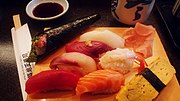
Certain cultures highlight animal and vegetable foods in their raw state. Salads consisting of raw vegetables or fruits are common in many cuisines. Sashimi in Japanese cuisine consists of raw sliced fish or other meat, and sushi often incorporates raw fish or other seafood as well. Steak tartare and salmon tartare are dishes made from diced or ground raw beef or salmon respectively, mixed with various ingredients and served with baguette, brioche or frites.[22] In Italy, carpaccio is a dish of very thin sliced raw beef, drizzled with a vinaigrette made with olive oil.[23] A popular health food movement known as raw foodism promotes a mostly vegan diet of raw fruits, vegetables and grains prepared in various ways, including juicing, food dehydration, sprouting, and other methods of preparation that do not heat the food above 118 degrees Fahrenheit.[24]
Cooking equipment and methods
Posted on 6:39 AM | Be the first to comment · edit

There are many types of cooking equipment used for cooking. Ovens are one type of cooking equipment which can be used for baking or roasting and offer a dry-heat cooking method. Different cuisines will use different types of ovens, for example Indian culture uses a Tandoor oven is a cylindrical clay oven which operates at a single high temperature,[17] while western kitchens will use variable temperature convection ovens, conventional ovens, toaster ovens in addition to non-radiant heat ovens like the microwave oven. Ovens may be wood-fired, coal-fired, gas, electric, or oil-fired.[18]
A stainless steel frying pan
Various types of cook-tops are used as well. They carry the same variations of fuel types as the ovens mentioned above. cook-tops are used to heat vessels placed on top of the heat source, such as a sauté pan, sauce pot, frying pan, pressure cooker, etc. These pieces of equipment can use either a moist or dry cooking method and include methods such as steaming, simmering, boiling, and poaching for moist methods; while the dry methods include sautéing, pan frying, or deep-frying.[19]
Traditional asado
In addition, many cultures use grills for cooking. A grill operates with a radiant heat source from below, usually covered with a metal grid and sometimes a cover. An open bit barbecue in the American south is one example along with the American style outdoor grill fueled by wood, liquid propane or charcoal along with soaked wood chips for smoking.[20] A Mexican style of barbecue is called barbacoa, which involves the cooking of meats and whole sheep over open fire. In Argentina, asado is prepared on a grill held over an open pit or fire made upon the ground, on which a whole animal is grilled or in other cases smaller cuts of the animal.[21]
Posted on 6:05 AM | Be the first to comment · edit
Posted on 6:05 AM | Be the first to comment · edit
Posted on 6:04 AM | Be the first to comment · edit
http://upload.wikimedia.org/wikipedia/commons/4/41/Slaughterhouse.jpg
Posted on 6:04 AM | Be the first to comment · edit
http://upload.wikimedia.org/wikipedia/commons/4/41/Slaughterhouse.jpg
Animal slaughter and butchering
Posted on 5:57 AM | Be the first to comment · edit
The preparation of animal-based food will usually involve slaughter, evisceration, hanging, portioning and rendering. In developed countries, this is usually done outside the home in slaughterhouses which are used to process animals en mass for meat production. Many countries regulate their slaughterhouses by law. For example, the United States has established the Humane Slaughter Act of 1958, which requires that an animal be stunned before killing. This act, like those in many countries, exempts slaughter in accordance to religious law, such as kosher shechita and dhabiĥa halal. Strict interpretations of kashrut require the animal to be fully aware when its carotid artery is cut.[10]
On the local level, a butcher may commonly break down larger animal meat into smaller manageable cuts and pre-wrapped for commercial sale or wrapped to order in butcher paper. In addition, fish and seafood may be fabricated into smaller cuts by a fish monger at the local level. However fish butchery may be done on board a fishing vessel and quick-frozen for preservation of qualitySW
Cooking
Posted on 5:46 AM | Be the first to comment · edit

The term "cooking" encompasses a vast range of methods, tools and combinations of ingredients to improve the flavor or digestibility of food. Cooking technique, known as culinary art, generally requires the selection, measurement and combining of ingredients in an ordered procedure in an effort to achieve the desired result. Constraints on success include the variability of ingredients, ambient conditions, tools, and the skill of the individual cooking.[12] The diversity of cooking worldwide is a reflection of the myriad nutritional, aesthetic, agricultural, economic, cultural and religious considerations that impact upon it.[13]
Cooking requires applying heat to a food which usually, though not always, chemically transforms it, thus changing its flavor, texture, appearance, and nutritional properties.[14] There is archaeological evidence of roasted foodstuffs at Homo erectus campsites dating from 420,000 years ago.[15] Boiling as a means of cooking requires a container, and was practiced at least since the 10th millennium BC with the introduction of potte
Production
Posted on 5:39 AM | Be the first to comment · edit
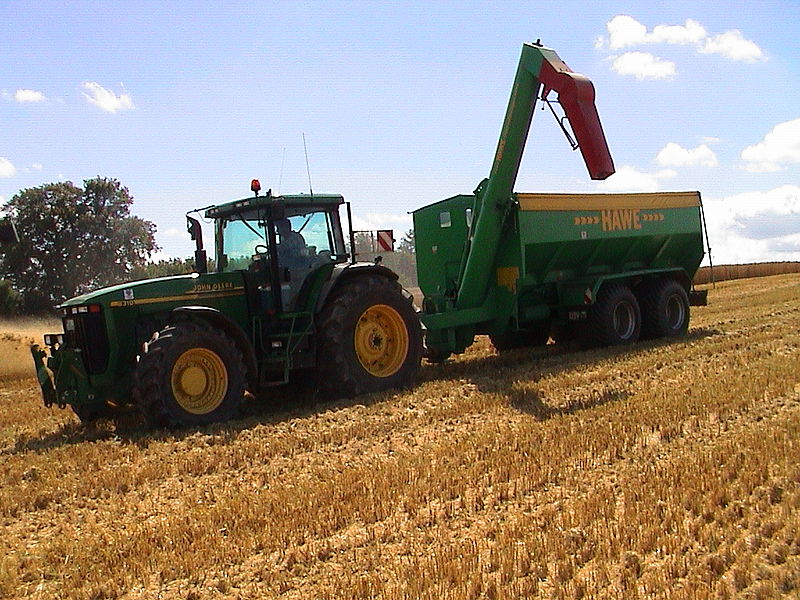
Main article: Agriculture
Food is traditionally obtained through farming, ranching, and fishing, with hunting, foraging and other methods of subsistence locally important. More recently, there has been a growing trend towards more sustainable agricultural practices. This approach, which is partly fueled by consumer demand, encourages biodiversity, local self-reliance and organic farming methods.[7] Major influences on food production are international organizations, (e.g. the World Trade Organization and Common Agricultural Policy), national government policy (or law), and war
Animals
Posted on 5:32 AM | Be the first to comment · edit

ain article: Animal source foods
Various raw meats
Animals can be used as food either directly, or indirectly by the products they produce. Meat is an example of a direct product taken from an animal, which comes from either muscle systems or from organs. Food products produced by animals include milk produced by mammals, which in many cultures is drunk or processed into dairy products such as cheese or butter. In addition birds and other animals lay eggs, which are often eaten, and bees produce honey, a popular sweetener in many cultures. Some cultures consume blood, some in the form of blood sausage, as a thickener for sauces, a cured salted form for times of food scarcity, and others use blood in stews such as civet.[
Plants
Posted on 5:27 AM | Be the first to comment · edit

Many plants or plant parts are eaten as food. There are around 2,000 plant species which are cultivated for food, and many have several distinct cultivars.[2]
Seeds of plants are a good source of food for animals, including humans because they contain nutrients necessary for the plant's initial growth. In fact, the majority of food consumed by human beings are seed-based foods. Edible seeds include cereals (such as maize, wheat, and rice), legumes (such as beans, peas, and lentils), and nuts. Oilseeds are often pressed to produce rich oils, such as sunflower, rapeseed (including canola oil), and sesame.[3] One of the earliest food recipes made from ground chickpeas is called hummus, which can be traced back to Ancient Egypt times.
Fruits are the ripened ovaries of plants, including the seeds within. Many plants have evolved fruits that are attractive as a food source to animals, so that animals will eat the fruits and excrete the seeds some distance away. Fruits, therefore, make up a significant part of the diets of most cultures. Some botanical fruits, such as tomatoes, pumpkins and eggplants, are eaten as vegetables.[4] (For more information, see list of fruits.)
Vegetables are a second type of plant matter that is commonly eaten as food. These include root vegetables (such as potatoes and carrots), leaf vegetables (such as spinach and lettuce), stem vegetables (such as bamboo shoots and asparagus), and inflorescence vegetables (such as globe artichokes and broccoli). Many herbs and spices are highly-flavorful vegetables.
© 2007 fooditems by Blogger Templates, wordpress by Template Panic
